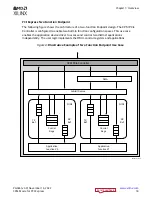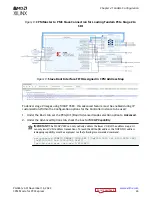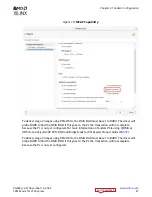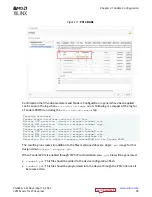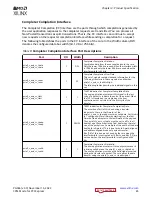
device, such as the R5 or A72 processors in the Scalar Engines, will be programmed after the
CPM and its PCI Express endpoint(s). While future enhancements to the Tandem Configuration
solution may open opportunities to quickly booting other dedicated parts of a target device, the
current solution focuses exclusively on PCI Express end points in the CPM only for the sole
purpose of meeting the 100 ms boot time requirement.
Loading Tandem PCIe for Stage 2
Design Requirements
The Tandem PCIe and DFX features inherently operate on the same datapaths for this discussion;
they both use the PCIe link to deliver bitstream data to the slave boot interface (SBI) buffer,
which is grabbed by a PMC DMA block and delivered to the platform processing unit (PPU) for
processing and delivery to be programmed to the configurable device resources. The SBI buffer is
an 8 KB FIFO and any write to the aperture will occur in order, regardless of the target address.
The mechanism for delivery through CPM varies depending on the chosen methodology, but all
require specific hardware design requirements and have accompanying software and driver
components. CPM4 Controller 1 does not have a hardened DMA controller connected to it, so
QDMA, XDMA, and Master Bridge delivery of a bitstream to the SBI would require the use of
soft IP or the Versal MCAP VSEC. CPM5 does not support the use of the XDMA controller.
Table 1: Bitstream Delivery Details from PCIe to SBI
Delivery Method
CPM4 HW Capable Ctrlr
0 / Ctrlr 1
CPM5 HW Capable Ctrlr
0 / Ctrlr 1
Software Driver
QDMA
Yes / No
Yes / Yes
Yes
XDMA
Yes / No
No / No
Yes
MCAP VSEC
Yes / Yes
Yes / Yes
Yes
Master Bridge
Yes / No
Yes / Yes
Yes
Note: It is possible to take advantage of CPM in streaming only mode with the RQ/RC/CQ/CC interfaces to
the PL and deliver reconfigurable partitions to SBI, but this would require a user-written soft IP DMA or
bridge and custom software and drivers. It is recommended to use the MCAP VSEC instead for ease of use
unless higher throughput is required. The MCAP VSEC can also be used with a user DMA or bridge to load
a Tandem PCIe Stage 2 bitstream since the path to the SBI does not require PL logic to be present.
For details on configuring a design in the Vivado Design Suite to support using MCAP VSEC or
DMA transfers for Tandem PCIe, refer to
Enable the Tandem Configuration Solution
. The
requirements to load a reconfigurable partition are the same as what’s described for Tandem
PCIe since the datapaths are the same. To configure a design for DFX and generate partial
bitstreams for reconfigurable modules, refer to Vivado Design Suite User Guide: Dynamic Function
eXchange (
Chapter 2: Tandem Configuration
PG346 (v3.3) November 16, 2022
CPM Mode for PCI Express
32

